$10,000 Blood Money
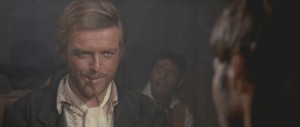 The Italian film industry sure loves their rip-offs. In the late 1960s, they made dozens of imitations of Sergio Leone’s Dollars Trilogy of Spaghetti Westerns (A Fistful of Dollars, For a Few Dollars More, The Good, The Bad, and The Ugly). In the mid 1970s, they made countless crime films, primarily inspired by The French Connection or The Godfather. And in the early 1980s, they focused on post-apocalyptic films ripping off either Escape from New York or The Road Warrior.
The Italian film industry sure loves their rip-offs. In the late 1960s, they made dozens of imitations of Sergio Leone’s Dollars Trilogy of Spaghetti Westerns (A Fistful of Dollars, For a Few Dollars More, The Good, The Bad, and The Ugly). In the mid 1970s, they made countless crime films, primarily inspired by The French Connection or The Godfather. And in the early 1980s, they focused on post-apocalyptic films ripping off either Escape from New York or The Road Warrior.
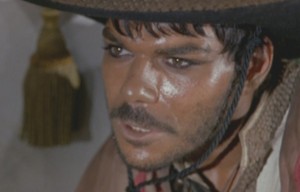 It goes without saying that most of these films are forgettable, running through the motions, ticking off the genre boxes, padding their way to 90 minutes, and changing the names of Italian actors and directors to sound more American. There are exceptions, of course, like 2019: After The Fall of New York, Il Boss, and Death Rides a Horse.
It goes without saying that most of these films are forgettable, running through the motions, ticking off the genre boxes, padding their way to 90 minutes, and changing the names of Italian actors and directors to sound more American. There are exceptions, of course, like 2019: After The Fall of New York, Il Boss, and Death Rides a Horse.
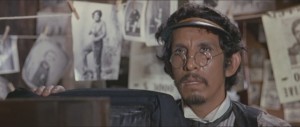 One such exception, Romolo Guerrieri’s $10,000 Blood Money, is basically a 2nd generation dilution of a rip-off. It’s a derivation of the Django series, starring Franco Nero, which was already a copy of A Fistful of Dollars (which was a legally binding rip-off of Yojimbo). Usually, those films would have some hint of their derivation in the title, but $10,000 Blood Money is one of only a few to use the Django character without mentioning it in the title. That might suggest that the film might attempt to present the “Man With No Name” archetype in a new light, but mostly, this Django sticks to the formula of a unshaven, poncho-wearing, cigarillo-smoking, sandy-haired bounty hunter, with a nihilistic view of life, and a gruff way of expressing it.
One such exception, Romolo Guerrieri’s $10,000 Blood Money, is basically a 2nd generation dilution of a rip-off. It’s a derivation of the Django series, starring Franco Nero, which was already a copy of A Fistful of Dollars (which was a legally binding rip-off of Yojimbo). Usually, those films would have some hint of their derivation in the title, but $10,000 Blood Money is one of only a few to use the Django character without mentioning it in the title. That might suggest that the film might attempt to present the “Man With No Name” archetype in a new light, but mostly, this Django sticks to the formula of a unshaven, poncho-wearing, cigarillo-smoking, sandy-haired bounty hunter, with a nihilistic view of life, and a gruff way of expressing it.
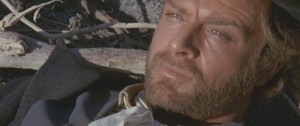 However, $10,000 Blood Money eschews Leone’s incessant need in the latter two Dollars films to show off and bloat his films past the two hour mark. Guerrieri delivers his 90 minute film in a smooth, patient, non-repetitive fashion, properly using the 2.35 frame without constantly making us notice how complicated a shot must have been to set up, or how much sweat covers the brow of an about-to-be dead Mexican by lingering on a close-up for an unusual amount of time. Guerrieri’s storytelling is downright efficient and expedient, getting to the nuts and bolts of Django’s core in the first 30 seconds and establishing his macabre sense of humor.
However, $10,000 Blood Money eschews Leone’s incessant need in the latter two Dollars films to show off and bloat his films past the two hour mark. Guerrieri delivers his 90 minute film in a smooth, patient, non-repetitive fashion, properly using the 2.35 frame without constantly making us notice how complicated a shot must have been to set up, or how much sweat covers the brow of an about-to-be dead Mexican by lingering on a close-up for an unusual amount of time. Guerrieri’s storytelling is downright efficient and expedient, getting to the nuts and bolts of Django’s core in the first 30 seconds and establishing his macabre sense of humor.
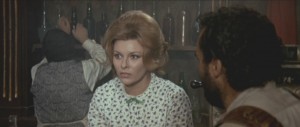 Our anti-hero (given the credit of Gary Hudson, which lead actor Gianni Garko stated was a combination of his inspirations, Gary Cooper and Rock Hudson, though Garko looks more like Christopher Lambert here), awoken from a night’s sleep on the beach, rolls over and begins talking to the dead man sitting next to him about his future aspirations. No doubt the man was one of Django’s many victims, and the key point here is that Guerrieri informs us that Django is both dangerous and nonchalant about it. It means that Django doesn’t have to mow down someone every few minutes just to remind us that he’s intimidating and care-free. Having the bodies pile up can get tiresome and remind us of a thrill-a-millisecond video game, removing the stakes almost instantaneously.
Our anti-hero (given the credit of Gary Hudson, which lead actor Gianni Garko stated was a combination of his inspirations, Gary Cooper and Rock Hudson, though Garko looks more like Christopher Lambert here), awoken from a night’s sleep on the beach, rolls over and begins talking to the dead man sitting next to him about his future aspirations. No doubt the man was one of Django’s many victims, and the key point here is that Guerrieri informs us that Django is both dangerous and nonchalant about it. It means that Django doesn’t have to mow down someone every few minutes just to remind us that he’s intimidating and care-free. Having the bodies pile up can get tiresome and remind us of a thrill-a-millisecond video game, removing the stakes almost instantaneously.
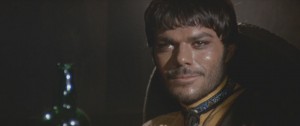 When Django is first approached, while he naps and smokes on a make-shift cot, to go after a nasty criminal, he offers more of a threat to the man making the financial offer than he would to his eventual prey. Irked by the low-balling bid, he says, “Why do you want to be killed by a man in drawers? It’s dubious.”
When Django is first approached, while he naps and smokes on a make-shift cot, to go after a nasty criminal, he offers more of a threat to the man making the financial offer than he would to his eventual prey. Irked by the low-balling bid, he says, “Why do you want to be killed by a man in drawers? It’s dubious.”
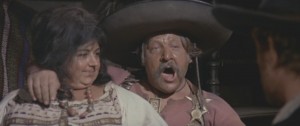 And how do we know the criminals are mean and nasty? Why, they kidnap women, and when they force a make-out session, they don’t react to the woman’s violent bite, rather they wait until they’re done with the kiss to tend to their now bleeding lip. Also, our villain wears a ton of eyeliner. That’s usually the giveaway that the guy doesn’t care what we or anyone else thinks. Claudio Camaso’s performance as said villain, Manuel Vasquez, is funny for a number of reasons besides the eye make-up; he knows Django is after him, but also knows Django won’t dare kill him until he’s worth more money. It’s why Manuel feels comfortable partnering up with Django at times, whether it is to steal gold or catch poker cheats. Camaso is hampered by a strange choice, which could be an intentional bit of humor, but is unlikely to be. His wanted poster looks more like Django than himself, either suggesting that the posters were drawn quickly and with little hint as to the actual look of the criminal, or that Camaso never told the art department that he was going to grow a beard. Or tell Guerrieri that he intended to play his character to look and sound like a spoiled child. It helps that the actor who plays his father looks just like blue-collar TV dad John Goodman [There’s also a Roseanne character, an older, heavyset drunk dancer, who is sort of an unofficial wife for Manuel’s father.]
And how do we know the criminals are mean and nasty? Why, they kidnap women, and when they force a make-out session, they don’t react to the woman’s violent bite, rather they wait until they’re done with the kiss to tend to their now bleeding lip. Also, our villain wears a ton of eyeliner. That’s usually the giveaway that the guy doesn’t care what we or anyone else thinks. Claudio Camaso’s performance as said villain, Manuel Vasquez, is funny for a number of reasons besides the eye make-up; he knows Django is after him, but also knows Django won’t dare kill him until he’s worth more money. It’s why Manuel feels comfortable partnering up with Django at times, whether it is to steal gold or catch poker cheats. Camaso is hampered by a strange choice, which could be an intentional bit of humor, but is unlikely to be. His wanted poster looks more like Django than himself, either suggesting that the posters were drawn quickly and with little hint as to the actual look of the criminal, or that Camaso never told the art department that he was going to grow a beard. Or tell Guerrieri that he intended to play his character to look and sound like a spoiled child. It helps that the actor who plays his father looks just like blue-collar TV dad John Goodman [There’s also a Roseanne character, an older, heavyset drunk dancer, who is sort of an unofficial wife for Manuel’s father.]
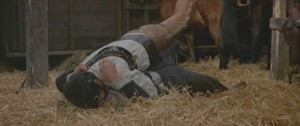 There’s more subtext than expected throughout the film, Django throws a lot of homoerotic dialogue, his relationship with his love interest is very forced (“your face implies that you’re not experienced in handling a woman”), and he doesn’t show real interest in her until she invites on a trip to San Francisco, where you can wear “fancy, stylish hats.” Is it fair to throw post-modern analysis onto a genre quickie from 1967? I’d say that Django’s relationship with his partner Fidelio (named after Beethoven’s opera where a woman dresses as a man to rescue her imprisoned husband) and villain Miguel, especially as they literally roll around in some hay, gives us a hint. Could Guerreri have known what he was doing? The way he uses the sad, powerful score by Nora Orlandi, closer to George Delerue (Jules and Jim) than to Ennio Morricone (The Good, The Bad, and The Ugly), suggests that he did.
There’s more subtext than expected throughout the film, Django throws a lot of homoerotic dialogue, his relationship with his love interest is very forced (“your face implies that you’re not experienced in handling a woman”), and he doesn’t show real interest in her until she invites on a trip to San Francisco, where you can wear “fancy, stylish hats.” Is it fair to throw post-modern analysis onto a genre quickie from 1967? I’d say that Django’s relationship with his partner Fidelio (named after Beethoven’s opera where a woman dresses as a man to rescue her imprisoned husband) and villain Miguel, especially as they literally roll around in some hay, gives us a hint. Could Guerreri have known what he was doing? The way he uses the sad, powerful score by Nora Orlandi, closer to George Delerue (Jules and Jim) than to Ennio Morricone (The Good, The Bad, and The Ugly), suggests that he did.
George Delerue’s score for Contempt :
Or download the full track.
(Right-click, Save Link As…)
Nora Orlandi’s theme from $10,000 Blood Money:
Or download the full track.
(Right-click, Save Link As…)



